
- Home
- About Us
- Our Books
- Discographies
- The Beatles
- Other Bands
- Capitol Records History
- Archives
What's new - August 2011
From the Capitol6000 news entry archives
08 23 2011
Recent Sales
Most recent sales have been added to the 2011 sales page, but some specific items caught our attention once more this week! First up was the relisting of the famous copy of the Decca My Bonnie that was listed last month, and even though it climbed to 4500$ the first time around, unfortunately this time, the seller was not so lucky - even at the buy it now price of 4500$
Also this week, the same person who sold a fantasy Canadian Butcher had up for sale a fantasy Canadian jukebox EP called Twist and Shout, sold with cover and jukebox strips and everything. This item found a curious buyer for 36$! Also, another no dash and number Love me Do was up for sale but even at 260$ did not meet the reserve price - it had a buy it now price of 995$. Finally, as far as singles go, Pink Floyd 's Julia Dream sold for 80$, even in VG condition!.
Now for LPs, the Let It Be Box set is always very popular, especially when it included the tray, and this one sold for 420$ with 25 bidders. Sounds Great, feat. the Yardbirds sold for 57.50$ while The Dave Clark Five's Everybody Knows and You Got What It Takes sold for 53$ and 104.50$ respectively. Finally, a shrink wraped copy of Hey Jude with the green apple sticker sold for 16$.
On a more personal note, Piers's two books were also for sale online this week, and sold for 41$ and 51$ each! There is clearly still a lot of interest for these two first volumes and even though we are working on new material, they should soon be available for sale once again directly from this website. Stay tuned!
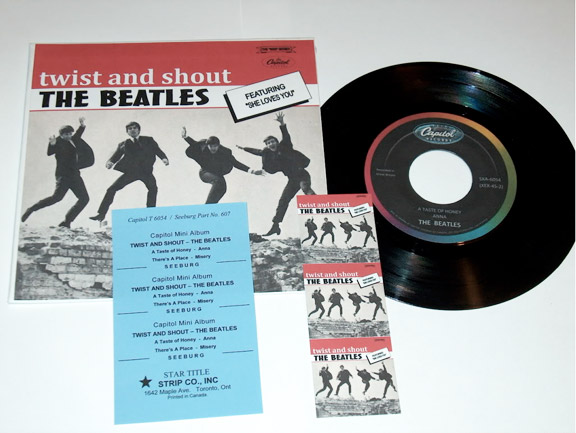
For more details on these sales, simply visit the 2011 sales page from the archive tab in the menu.
08 11 2011
Did You Know?
The Origin Of The Album
Written by Serge Pelletier
Source: Travis Elborough /// The Long player Goodbye
The Long Playing album (LP) was born in the early 20th century after technological innovations, governmental restrictions and marketing strategies to boost sales. The name still lives today and remains the industry standard even though our way of listening to music evolved as formats changed through the years, but have you ever wondered why it was called an "ALBUM"?
Plain and simple, in the early days of recorded music, the standard format was 78 RPM 10 inch discs that contained only a few minutes of music on each side, so when one wished to buy a complete classical symphony for example, the master piece came in a collection of many records and these discs usually were sold in a cardboard ALBUM, where the discs were placed in individual sleeves, attached to the book like the pages of a photo album.
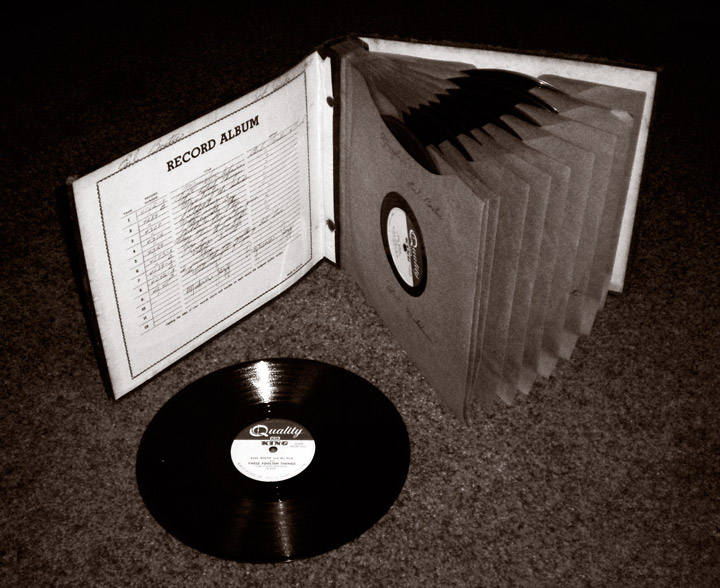
So why do we still call it an album if records have obviously not been sold in such packagings for the past 60 years? The story all started when Columbia popularized the new Long Playing Microgroove format in 1948 where all fifteen 78 RPM discs of an album would fit on one single record. From then on, the music industry was changed forever - EVERYTHING changed - the way music was sold, packaged, recorded, composed and listened to… Albums simply became soundtracks to each of our lives. As Travis Elborough so smoothly explained: "the album was welded in our collective consciousness". Emile Berliner could never have imagined that by creating a disc format that could be mass reproduced, the world would be changed, generations at a time.
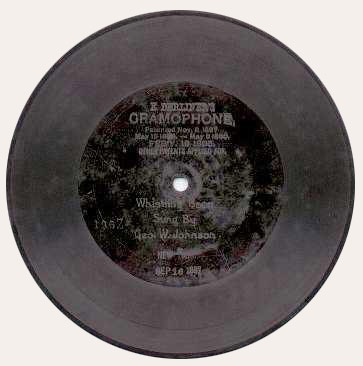
An original Berliner disc
The album as we know it today did not magically become popular over night in 1948 though… RCA experimented with long playing discs years before Columbia. In 1932 in fact, RCA had produced the first LP made of vinylite, a refined version of Bakelite; a synthetic plastic developed in 1907. The project did not really take off yet as vinylite, although being quite resistant compared to the old breakable 78s discs, was in fact much softer than shellac and the weighty pickups of the 1930s would simply carve through the soft plastic in a matter of weeks… Lightweight tone arms were still to come.
Edward Wallerstein, an ex RCA employee that worked on the project back in the 30s, did not forget the idea and saw an opportunity when suddenly all the stars aligned.. After the depression and during World War II, records sales were down, and shellac was actually limited as part of the war effort; at one point, people had to bring back old shellac records before being allowed to buy new ones! A ban on recording new material was also voted in the early 40s because it was thought that recorded music would kill live performances and its radio airplay. The only exceptions were for the armed forces where many " V-discs" were produced for over seas army personnel. However, shipping shellac discs over seas would prove to be very risky as they would, in most cases, break! Therefore, the need to find a new alternative was there, and Wallerstein jumped on the occasion to revive the long gone LP disc.
As he presented his new idea to the media in New York City in 1948, the public was obviously stunned by the fact that an 8 feet stack of 78s could now fit in a 15 inches pile of LP albums. Most importantly, they were blown away by the sound quality of this new type of record! Vinylite being a soft plastic, had a bright crisp clean sound compared to the constant hiss of the shellac discs (fillers such as emery powder and limestone gave a distinctive sound to shellac records). To add to the matter, the LP had much smaller groove and spun slower, therefore dramatically increasing the minutes of music on each side without having to change records. It was a whole new experience. From this point on, listening to an album actually became an experience in itself!
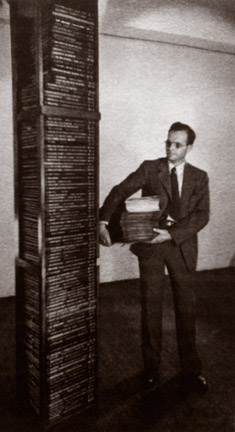
Photo: from the Long Player Goodbye by Travis Elborough
The number of minutes on an album was not determined by accident. Wallerstein was asked to find the appropriate number of minutes that would allow to call the record " long playing"; it also had to fit most classical works. So timing a series of symphonies, he came to the conclusion that 17 minutes per side was optimal and would cover around 90% of classical works featured in their catalogue. The speed was no accident either. In 1927, the Vitaphone Film Company did extensive research to maximize the speed of a record in order to fit an 11 minute film reel without any distortion on a decent size disc. 33 ⅓ RPM was deemed best and became the industry standard.
Not seeing themselves licensing the technology, Columbia gave the technology for free to other companies who wished to press LPs as well. Capitol and its new Canadian branch saw the potential and pressed LPs almost immediately after opening their new plant in London Ontario. It should be noted however, that not all companies saw a future in the 33 rpm disc. RCA, possibly a little bitter for losing its original idea to Columbia decided to push its new format: the 45 RPM 7 inch disc. Even though a step up from the 78 in both space and sound quality, it was pale in comparison to the 12 inch LP. A symphony would still fit on 4 discs instead of one single album. This meant that in order to get a smooth listening experience with automatic disc changers, the records were prepared in such a way that side 1 was backed with side 8, side 2 with side 7 etc. All too confusing in the end. Fortunately for RCA, their efforts were not in vain since although having no choice to follow in the footsteps with the new format, 45s made their way to the pop charts where a single could feature 2 new songs promoting the artist's album.
Another interesting fact was that "ALBUMS" were a technological revolution, but were still packaged in a dull tan sleeve. Columbia had the idea of experimenting with attractive eye catching artwork on cardboard jackets that would feature the music carved in the grooves. After a few trials, they have seen sales climb up dramatically; Beethoven's 9th symphony rose 894% alone!! Albums were soon to become the canvas for creative artwork, especially as artists became more involved in the different spheres of the album making process.
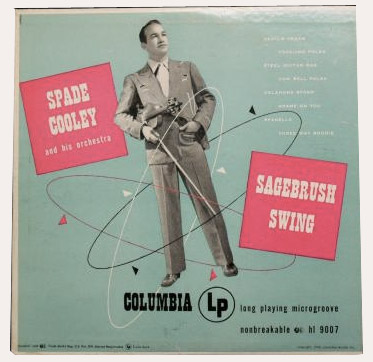
A good example of the new colorful artwork featured on newly created cardboardsleeves in 1949
Albums were clearly a revolution from a technological point of view, but never would they have guessed it would become one from a social and cultural point of view as well. The new format forced on the industry a new way of packaging and mostly of recording albums - recording one 17 minutes long flawless live take was a lot more complicated than the short 4 minutes found on a 78 RPM. Mastering and editing was a lot more complicated too when recording directly to disc… That is when magnetic tapes and later multitrack recording changed the face of music forever. These changes paved the way for bands to push the limits of these new technologies, exploring new way to record, create and present their ideas - actually making the recording process a creative process! Without the Long Playing album, Concept albums like Sgt pepper's Lonely Hearts Club Band, or The Wall could never have existed.The length of the new format defined the way a project was now conceived, and incidentally, the way it was listened to. Bands started working with the format, creating concept albums instead of simple collections of songs, as it used to be the norm (and by definition, what an album was at first!).
So the album dissociated itself from its original vocation and literally transformed into a social entity that is today anchored in our everyday life. Even though digital downloads changed our way of browsing and listening to music as linear albums in the past few years, "the semantics of the album remains" (T.E.). The output has changed, but the input still remains sensibly the same - most artists still create albums as projects and works of art, even though songs can be bought separately.
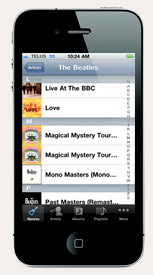
And since everything that goes around comes around, interestingly enough, the vinyl market has seen a dramatic increase over the past few years, almost as if new generations feel the need to rediscover the pleasure of LISTENING to an album as an experience. MP3s are great to discover and to listen to on the go, but to sit down and listen to music implies a ritual that has been lost with new technologies. As the natural balance of things goes, it seems that from a sea of free for all tracks available at anytime from anywhere, people start appreciating the importance of taking the time to listen to a piece of art, slowly bringing back this balance after a period of excessive availability.
For a great book on Long Playing album, make sure to read The Long Payer Goodbye by Travis Elborough.
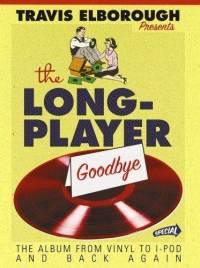
08 11 2011
August 2011 record of the month:
Profile In Sound" An Introduction To Singing Sensation Helen Shapiro
Especially Prepared For Radio Station and T.V. Programming
A Capitol Records of Canada, Ltd. Promotion Record (CC-PRO-2)
Approximate time of the recording is 14 minutes and 30 seconds.
Recorded in London in early 1962. The interviewer is unknown.
The album includes four of her songs; Please Don't Treat Me Like A Child, You Don't Know, Tiptoe Through The Tulips, Walkin' Back To Happiness.
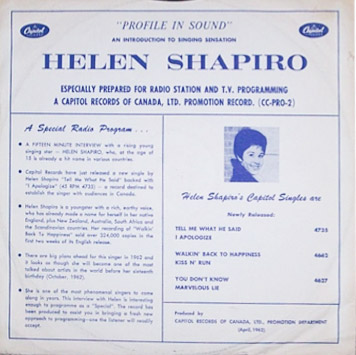
This cool one-sided Lp was issued by Capitol of Canada in April 1962, when Helen was still just 15 years old ! Helen was born on September 28th., 1946.
There were probably only 100-200 of these discs pressed by RCA Victor at their Smiths Falls, Ontario pressing plant.
In early 1963, The Beatles undertook their very first national tour of England as a support act to Helen Shapiro .. who was "top of the bill". In fact, The Beatles were the "bottom" act of the eight acts on the tour roster. The other acts on the tour ranking ahead of The Fab Four were The Red Price Combo, The Kestrels (who would do a terrific cover of "There's A Place" on UK Piccadilly), The Honeys, Dave Allen (comedian), Kenny Lynch, Danny Williams, Billie Davis (last portion of the tour) and of course Helen Shapiro. The tour commenced on February 2nd. 1963 and ended on March 3rd., 1963. For Beatles fans, it is important to note that The Beatles recorded their first album "Please Please Me" on one of their days off during this tour - that very long day for them was Monday, February 11th., 1963. The Beatles toured on their own from February 12th., 1963 to February 23rd., 1963 when they re-joined the Shapiro tour (Source" Mark Lewisohn "The Beatles Live"). The third single "From Me To You" was written by Lennon and McCartney on a "Helen Shapiro tour bus" on Thursday, February 28th., 1963.
So the Beatles connection to Helen Shapiro would be significant …
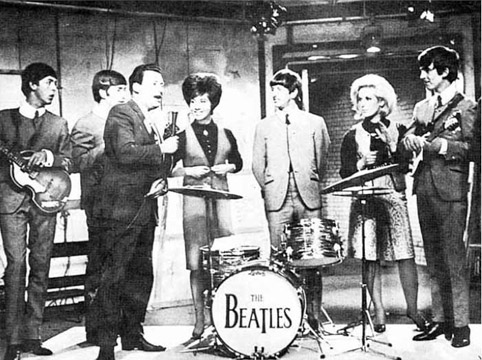
Above - The Beatles appear on their very first Ready Steady Go TV show with Helen Shapiro and Dusty Springfield, hosted by presenter Keith Fordyce (Friday, October 3rd., 1963, Source: Mark Lewisohn)
Paul White at Capitol was impressed enough with Helen Shapiro to issue this promotional album .., and she would have even more hits to follow ... now can you imagine if he had issued one of these one-sided promotional albums for The Beatles sometime during 1963 ? Now that would be something to look for !
Click HERE to listen to an excerpt of this promo record.
For the complete article, please visit the Record of the month page HERE
08 08 2011
August 2011 Update On The Beatles: The Complete Story, Volume One
Here Beatles author emeritus Mark Lewisohn talks about the forthcoming publishing date for his first of three volumes called "The Beatles: The Complete Story" which will be published by Little Brown in the UK and Crown Publishing in the USA. It will also be published in Japan.
https://www.youtube.com/watch?v=QiXWZz2Bqlg
We are all looking forward to seeing these books on our shelves.
08 03 2011
Recent Sales
Another very prolific few weeks in terms of sales! An early 70s pressing of Beatlemania sold for 135$, while other regular rainbow copies sold for 50$ and 150$ respectively. Twist And Shout sold for 50$ and Long Tall Sally for 100$. Another early 70s sealed record, this time Beatles VI sold for 25$ While Pink Floyd Animals (also sealed) found a new home for 86$. A cool Freddie And The Dreamers sold for 48.50$ while a rare Canadian copy of the Big Hits From England and the USA sold for 15$.
One Last item that sold raised a few eyebrows as it was a fantasy item; it is mentioned here because not many fantasy items are Canadian! This fake Canadian butcher was never meant to be passed as an authentic one, but still found a buyer for 82$ with its added Parr's logo !!!
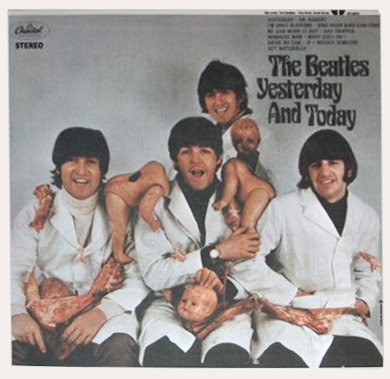
As far as singles go, Sie Liebt Dich is always a popular record and a VG- copie traded hands for 51$. A bunch of run down US singles was on ebay lately, but this sale is mentioned because it had the red MGM picture sleeve for WHY that was imported in small quantities in Canada; it sold for 46$. My Bonnie on MGM sold for 41$ while a regular copy of Love Me Do sold for 11$.
For more details on these sales, simply visit the 2011 sales page from the archive tab in the menu.
Copyright © 1999 - 2018
Capitol6000 & Hemmingsen Publishing
Piers A. Hemmingsen & Serge Pelletier. All Rights Reserved.